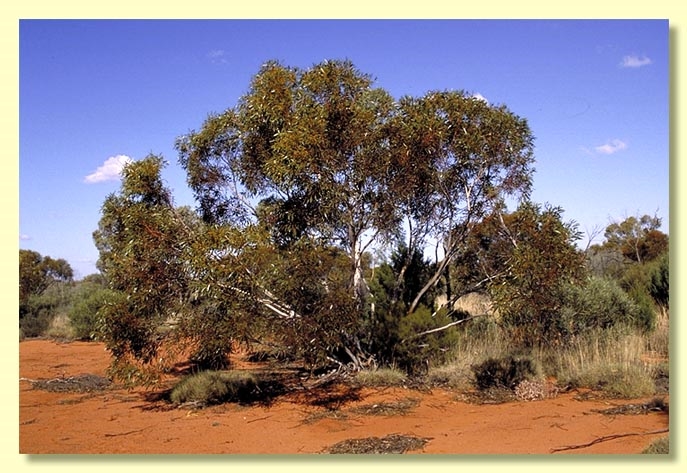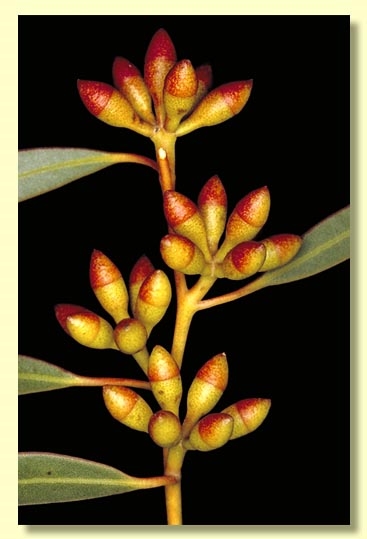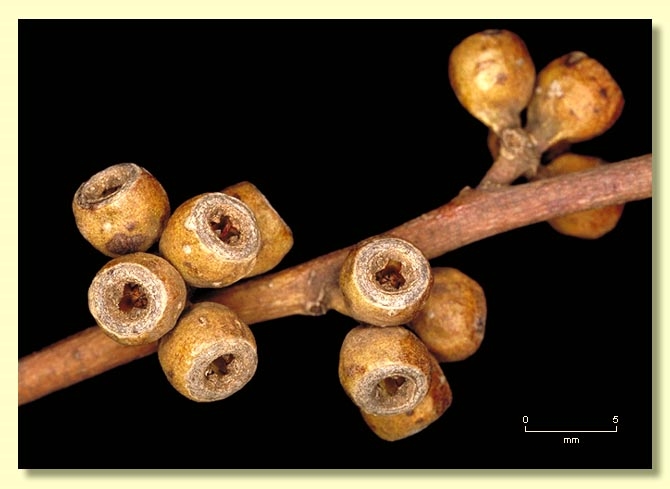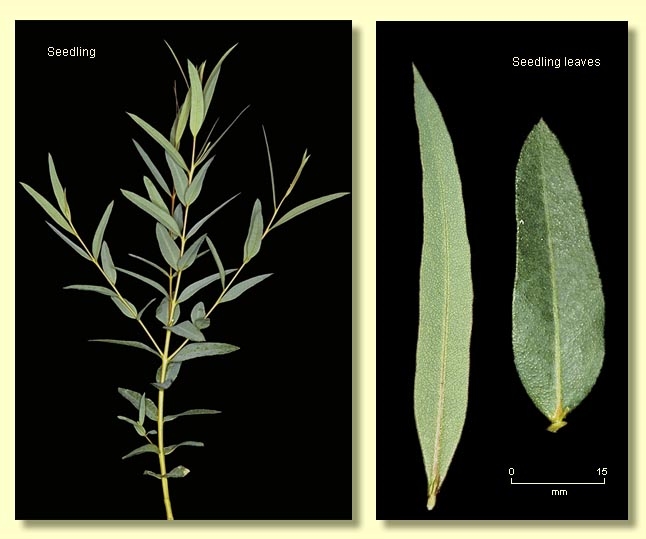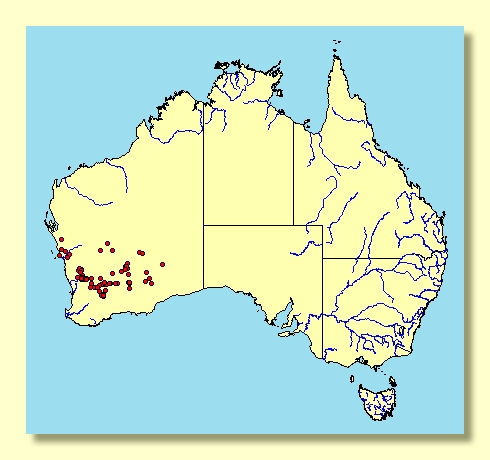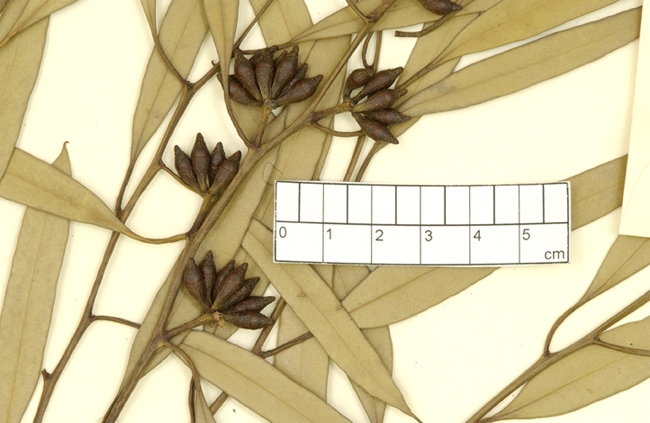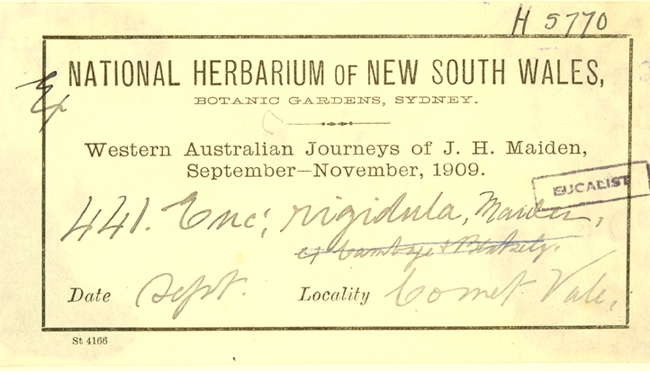Eucalyptus | Symphyomyrtus | Bisectae | Destitutae | Porantherae | Longiores
Euclid - Online edition
Eucalyptus rigidula
Bark smooth throughout, white, pale grey and pale brown to salmon-brown, rarely powdery, or with persistent ribbony rough fibrous grey-brown bark on lower trunk.
Branchlets lacking oil glands in the pith.
Juvenile growth (coppice or field seedlings to 50 cm): stems rounded in cross-section; juvenile leaves shortly petiolate, alternate, linear to narrowly lanceolate-elliptic, 5–9(13) cm long, 0.5–1(1.5) cm wide, green, glossy.
Adult leaves alternate, petioles 0.5–1.5 cm long; blade narrowly elliptic-lanceolate to linear, 4.7–10 cm long, 0.4–1.7 cm wide, base tapering to petiole, margin entire, apex pointed, concolorous, glossy, mid-green, thickish, side-veins at an acute or wider angle to midrib, reticulation dense, intramarginal vein close to margin, oil glands scattered or few, intersectional.
Inflorescence axillary unbranched, peduncles slightly flattened, 0.2–1.3 cm long, buds (?7)9 or 11, pedicellate, pedicels 0.1–0.5 cm long. Mature buds ovoid to fusiform (0.8–1.2 cm long, 0.3–0.5 cm wide), scar present, operculum conical to beaked (0.3–0.7 cm long), stamens inflexed, anthers cuneate-cuboid, adnate to filament apex (rigidly basifixed), dehiscing by sub-terminal pores, a few of the innermost stamens imperfectly formed, style long and straight, stigma tapered, locules 3(4), the placentae each with 4 vertical rows of ovules. Flowers creamy white.
Fruit pedicellate, sometimes shortly so, pedicels 0.1–0.5 cm long, barrel-shaped to truncate-globose to funnel-shaped to hemispherical, 0.4–0.8 cm long, 0.5–0.8 cm wide, disc level to descending, valves 3(4), more or less enclosed.
Seeds brown, 1–2.5 mm long, flattened-ovoid, sometimes pointed on one end, dorsal surface occasionally with longitudinal furrows, surface smooth, hilum ventral.
Cultivated seedlings (measured at node 10): cotyledons Y-shaped (bisected); stems rounded in cross-section; leaves sessile or subsessile, opposite, narrowly elliptic-ovate to oblong, discolorous, dull green for ca 6–13 nodes then becoming shortly petiolate, narrowly lanceolate to linear, alternate by node 7–14, glossy or dull, green and thicker. At ca node 10 leaves are 3.3 –10.5 cm long, 0.3–2 cm wide.
Flowering has been recorded in January, February, March, May and December.
A mallee species endemic to Western Australia occurring in the wheatbelt, goldfields and western edges of the Great Victoria Desert south to Zanthus. As treated here it excludes coastal plain plants from Wongan Hills north to Northampton and also excludes plants in the south-western wheatbelt area of Kalgarin–Kondinin–Bendering which may be closer to E. latens. Herbarium specimens from plants at Newman Rock west of Balladonia were given the name "Eucalyptus clancularia" by K.D. Hill of New South Wales National Herbarium, with the specimen Hill 266 being distributed as an isotype, but the name was never published. Seedlings grown from this locality (M.I.H. Brooker 13018, 13019) were no different to seedlings of E. rigidula from across the range of the species and the adult plants fall within the range of variation found elsewhere. Therefore "E. clancularia" is included here.
Eucalyptus rigidula belongs in Eucalyptus subgenus Symphyomyrtus section Bisectae subsection Destitutae because the buds have two opercula, cotyledons are Y-shaped and branchlets lack oil glands in the pith. Within this subsection E. rigidula belongs to a group of about 16 species, series Porantherae, that are further characterised by having anthers completely adnate to the staminal filaments, strongly inflexed stamens, densely reticulate leaves with intersectional oil glands and by the fruit with a distinct thick rim that includes a whitish descending disc. The small, glossy leaves of species in series Porantherae may result in confusion with species in series Heterostemones; however, the fruit alone usually distinguish the series. The fruit of series Heterostemones are thin-rimmed.
Typically E. rigidula is smooth-barked with a glossy green fairly stiff-leaved crown, has juvenile leaves that are linear, green and glossy and fruit with a thickish rim. Within its distribution it is most likely to be confused with E. horistes, which typically has some rough bark and glaucous slightly warty orbicular juvenile leaves. East from the Great Victoria Desert and extending to the eastern states another smooth-barked mallee occurs, E. leptophylla, distinguished from E. rigidula by smaller fruit and smaller elliptical-oblong grey to glaucous juvenile leaves.
Plants on the coastal sandplain in the area north from Wongan Hills to Kalbarri probably represent an undescribed taxon with dull grey-green, shorter, wider seedling and juvenile leaves and coarser, more barrel-shaped fruit than is typical. It is treated here separately as Eucalyptus sp. Kalbarri. Desert populations of E. rigidula may have very few oil glands in the leaves compared with more southern forms but this requires much field investigation to confirm.

